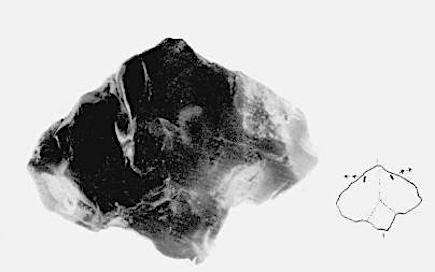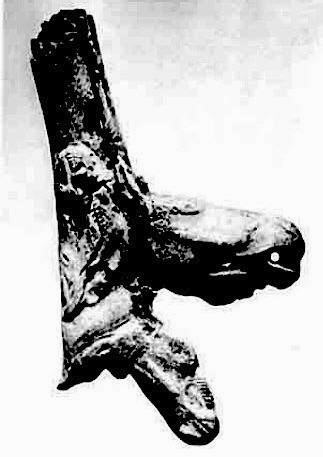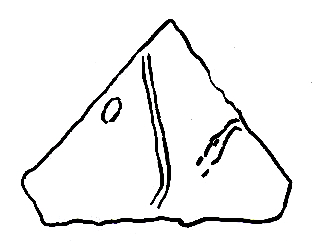- from 750,000 to 400,000 years ago (Acheulean and early Clactonian);
- from 400,000 to 200,000 years ago (Acheulean and Middle Clactonian);
- from 200,000 to 40,000 years (Acheulean and Final Clactonian, and Mousterian);
- from 40,000 to 12,000 years ago (Upper Paleolithic).
The typology of sculptures is comprised of representations of two heads of mammals joined at the neck, looking in opposite directions (Fig. 11.1).
These types are rare in the Paleolithic and also in historic epochs and in ethnography; it is often difficult to find photographs of them in books, where illustrations are generally reserved for more pleasant subjects.

Fig. 11.1) Zoomorphic bicephalic stone sculpture representing two mammal heads joined at the neck, and looking in opposite directions. The neck tapers to a point. The sculpture is in flint and under the two jaws it tapers to a point, so that by holding the sculpture by the two extremities (top and bottom) it can be rotated, and the expressivity is enhanced.
Height: 2.3 inches; Width: 0.23 inch.
Origin: Senigallia, Ancona, Italy.
Material culture: Clactonian or Middle or Final Acheulean.
Collection of the Museum of the Origins of Man.

This sculpture is of excellent workmanship for various reasons: 1) the technology is better than that of previous periods; 2) the artist was very skilled; 3) the cultural and spiritual context of the civilization that produced it was remarkable; 4) the material used allows realizations, that were not possible in stone sculptures made with stone tools available in the Paleolithic.
Dimensions: small.
Origin: Mas d'Azil Cave, Ariège, France.
Location: Musée d'Archéologie nationale (National Archeological Museum), Saint-Germain-en-Laye.
Material culture: Upper Paleolithic. ÂÂ

Dimensions: 2.5 inches x 2 inches x 0.40 inch.
Origin: Bédeilhac, France.
Material culture: Upper Paleolithic.
Location: Musée de Préhistoire Régionale (Regional Prehistory Museum), Menton, France.
Copyright©2020 by Museum of the Origins of Man, all rights reserved.